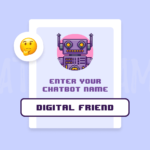Nowadays, clients expect a top-notch experience when interacting with a business, including fast and proactive support and self-service options.
Customer service chatbots can help you achieve all these, and then some.
But how do you know which ones are the best for your specific needs?
We’ve got your back—
We spent hours finding the top platforms to present you with a full comparison of each tool, including the ratings, features, and pricing. You can use this info to supercharge your client interactions.
First things first—
What is a customer service chatbot?
A customer service chatbot is a conversational tool usually powered by artificial intelligence (AI) that engages in conversations with clients. It helps to automate customer support by providing assistance, answering questions, and resolving issues.

Bots in customer service easily recognize common speech patterns of visitors at different stages of their customer journey. This allows them to understand user intent and provide relevant information, freeing up human customer service agents to handle more complex tasks.
Now, you should note that there are two types of chatbots most commonly used for customer service: rule-based and AI-powered bots:
- Rule-based bots operate based on predefined sets of rules and decision trees. They excel at providing quick responses to frequently asked customer questions.
- AI chatbots leverage natural language processing (NLP) and machine learning (ML) technologies to simulate human-like interactions. They learn from previous conversations and understand context and user intent.
As such, AI bots are ideal for addressing various customer needs and resolving complex issues.
Tidio’s Lyro is a great example of an AI chatbot for customer service. It learns from user interactions and delivers human-like answers within seconds.

Read more: Explore different chatbot types and learn the best ways to use them for your business.
Now—
Let’s find out—which customer support chatbot software on the market offers the richest array of features.
Top 10 chatbots for customer service
From AI chatbots to automations and analytics, the tools we’ll talk about have features that will help you streamline many of the mundane support tasks. CS chatbots on our list can also help reduce the workload of your reps, allowing them to focus on more complex customer inquiries.
Here’s a table of each tool we’ll cover for a quick comparison:
| Platform | G2 rating | Free plan | Best for |
|---|---|---|---|
| Tidio | 4.7/5 ⭐️ | ✅ | Rule-based and AI chatbots |
| Gorgias | 4.6/5 ⭐️ | Free trial | Personalized automations |
| Intercom | 4.5/5 ⭐️ | Free trial | Ready-to-use chatbot templates |
| HubSpot | 4.4/5 ⭐️ | ✅ | CRM software integration |
| Zendesk | 4.3/5 ⭐️ | Free trial | Help desk management features |
| Ada | 4.6/5 ⭐️ | ❌ | Ease of use |
| ProPofs Desk | 4.7/5 ⭐️ | ✅ | Issue tracking |
| Zoho Desk | 4.4/5 ⭐️ | Free trial | Contextual AI |
| Freshchat | 4.4/5 ⭐️ | ✅ | Shared inbox |
| Drift | 4.4/5 ⭐️ | ❌ | Detailed reporting and analytics |
Let’s take a look at more in-depth reviews of the best customer service chatbot software:
1. Tidio

Rating: 4.7/5 ⭐️ (1,440+ reviews)
Tidio is an all-encompassing customer service chatbot platform that includes a no-code bot builder and a live chat feature. Aside from automated chat flows, customers can also use Lyro, Tidio’s virtual AI assistant capable of answering most commonly asked questions using natural, conversational language. It also offers dedicated ecommerce integrations with all of the major platforms.
Main features:
- Lyro AI assistant that uses natural language
- Over 30 chatbot templates to choose from
- FAQ bots you can optimize for any business type
- A wide variety of chat triggers available
- Integrations with Instagram, Zapier, Facebook, and more
- An iOS and Android mobile app
Pricing:
- 7-day free trial available
- Free version available
- Starter ($29/mo)
- Growth (starts at $59/mo)
- Plus (starts at $749/mo)
- Premium (starts at $2999/mo)
Read more: Learn how to create a good FAQ for Lyro.
2. Gorgias

Rating: 4.6/5 ⭐️ (500+ reviews)
Gorgias is a good option for medium-sized businesses as it combines a Shopify chatbot tool with a ticketing system. It’s a useful tracking and segmentation platform that allows companies to offer a more tailored approach to their customers. There are also AI-based features and flows you can use to create personalized automations and elevate your support.
Pros:
- Integrations with social media, messaging platforms, etc.
- Chat flows for customer service
- Intent and sentiment detection
- Tracking updates available
Cons:
- Focuses mainly on ecommerce
- Limited reporting features
- Free 7-day trial available
- Starter ($10/mo)
- Basic ($60/mo)
- Pro ($360/mo)
- Advanced ($900/mo)
- Enterprise → Contact sales
Read more: Take a look at the best Gorgias alternatives on the web.
3. Intercom

Rating: 4.5/5 ⭐️ (2,950+ reviews)
This is a customer service chatbot solution ideal for large businesses and enterprises. Intercom provides a wide range of tools that will help your company improve customer interactions and experiences. It offers chat surveys for client feedback collection, tracking customer engagement, and automatically sorting visitors into categories. In addition, it lets you add rules to your support funnel for better workflow automation.
Pros:
Cons:
- Difficult to use with a steep learning curve
- Content organization into folders is not possible
- Free 14-day trial available
- Essential ($39/per seat/mo)
- Advanced ($99/per seat/mo)
- Expert ($139/per seat/mo)
Read more: Check out the best Intercom alternatives that can be found on the web.
4. HubSpot
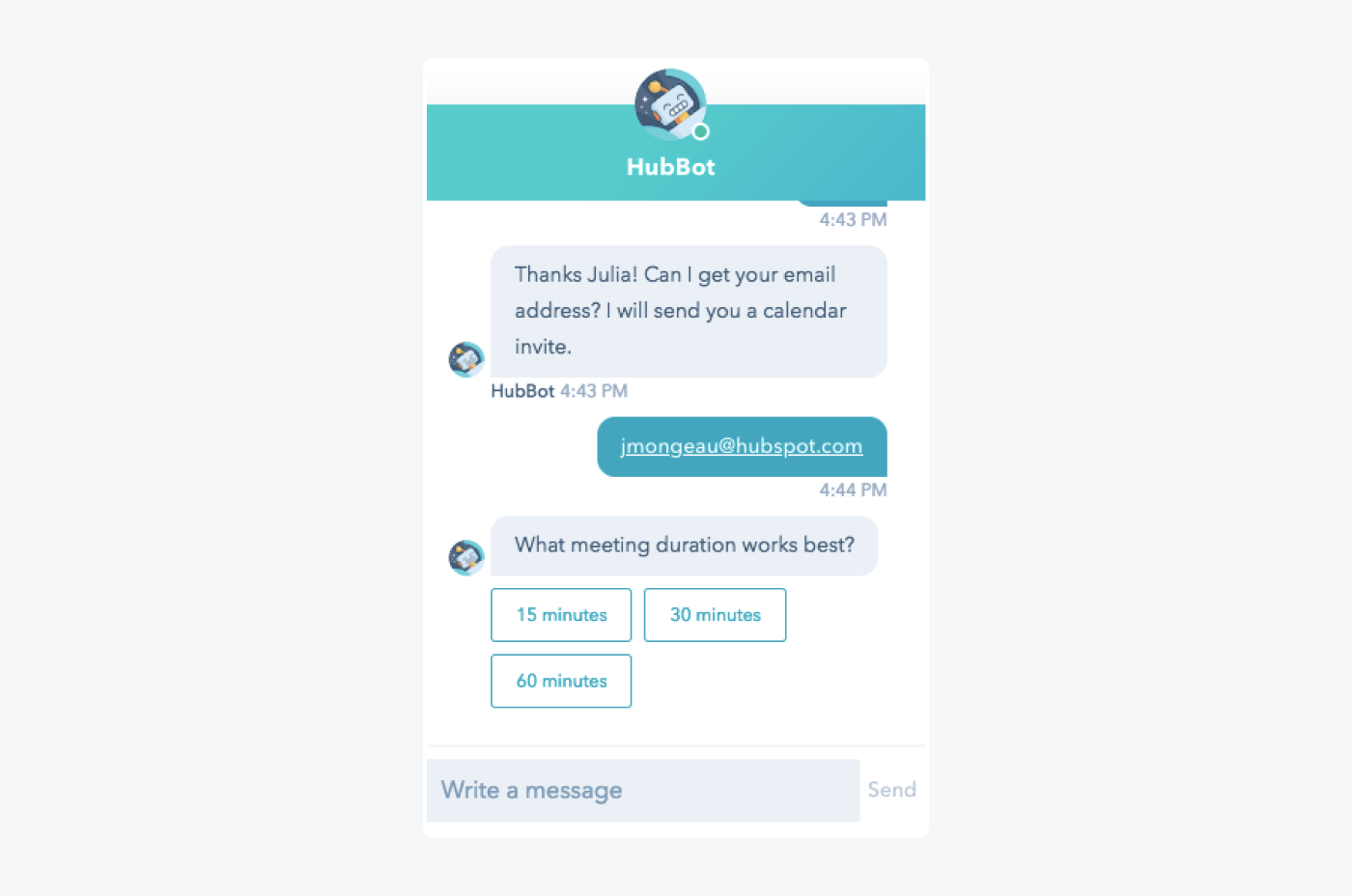
Rating: 4.4/5 ⭐️ (2,230+ reviews)
HubSpot primarily offers marketing and sales software to help your business grow its revenue and number of subscribers. It provides a CRM system to keep track of your customer communications and organize your interactions better. Overall, this customer service chatbot platform gives you a great suite of tools to help you with marketing, sales, and client support.
Pros:
- Customer service and sales chatbots
- Well-organized and easy-to-navigate user interface
- Shared inbox for all client requests
- Various integrations, such as Salesforce, Zapier, and Gmail
Cons:
- Free version available
- Starter ($20/mo)
- Professional (Starts at $1,200/mo)
- Enterprise (Starts at $4,000/mo)
Read more: Learn about the best HubSpot alternatives on the market.
5. Zendesk
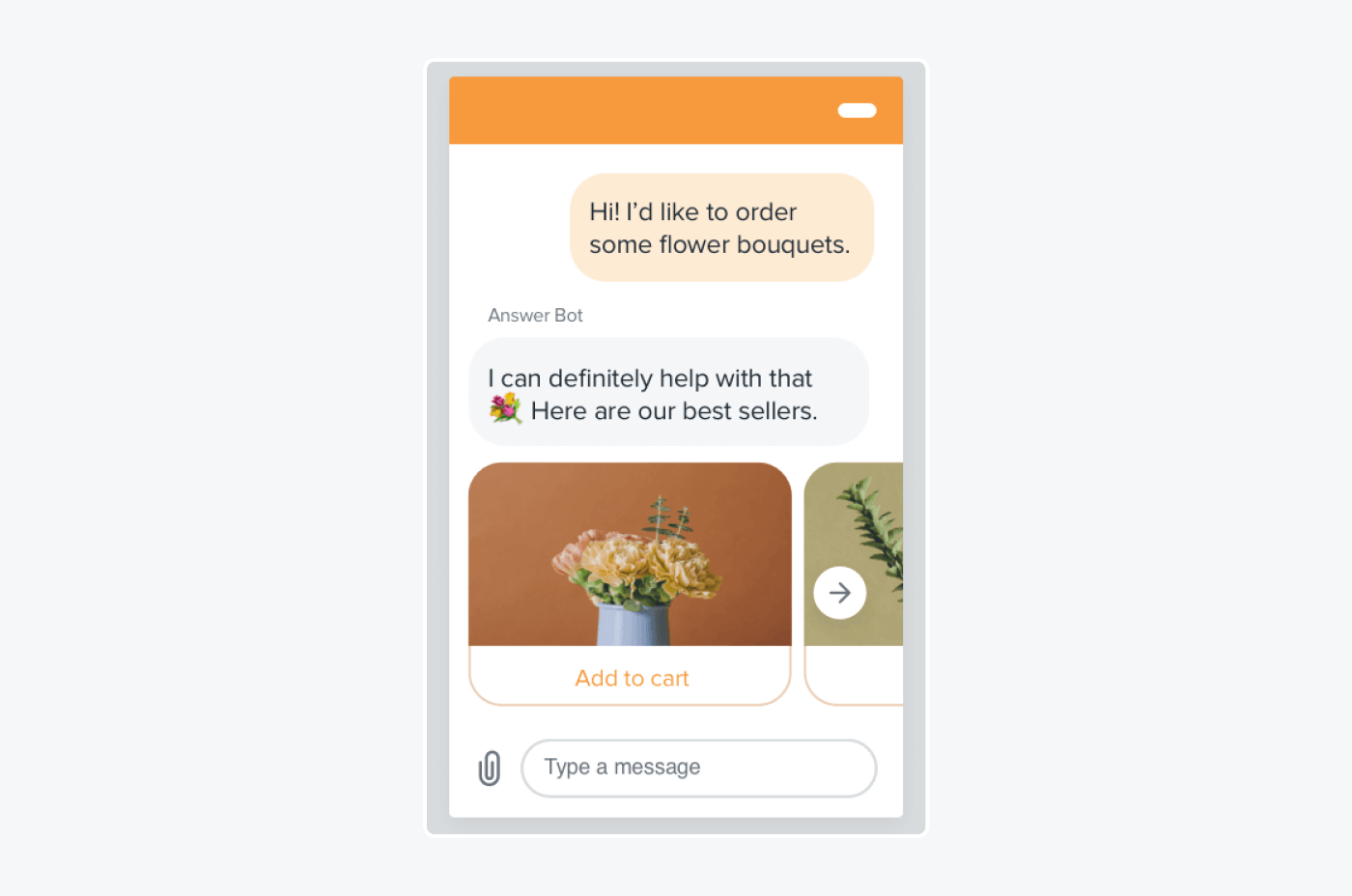
Rating: 4.3/5 ⭐️ (5,815+ reviews)
Zendesk provides a cloud-based customer service AI chatbot solution with agent role permissions, web SDKs, and operating hours. You can put this tool on any channel you like, including email, social media, WhatsApp, and more. This customer service chatbot for websites is easy to use and offers handy features for sales, marketing, and your team that handles support tickets.
Pros:
Cons:
- Few data transfer issues reported
- Navigation and system layout need improvements
- Free 14-day trial available
- Support team ($25/agent/mo)
- Support Professional ($69/agent/mo)
- Support Enterprise ($149/agent/mo)
- Suite Team ($69/agent/mo)
- Suite Growth ($115/agent/mo)
- Suite Professional ($149/agent/mo)
- Suite Enterprise → Contact sales
- Suite Enterprise Plus → Contact sales
Read more: Explore top Zendesk alternatives and competitors.
6. Ada
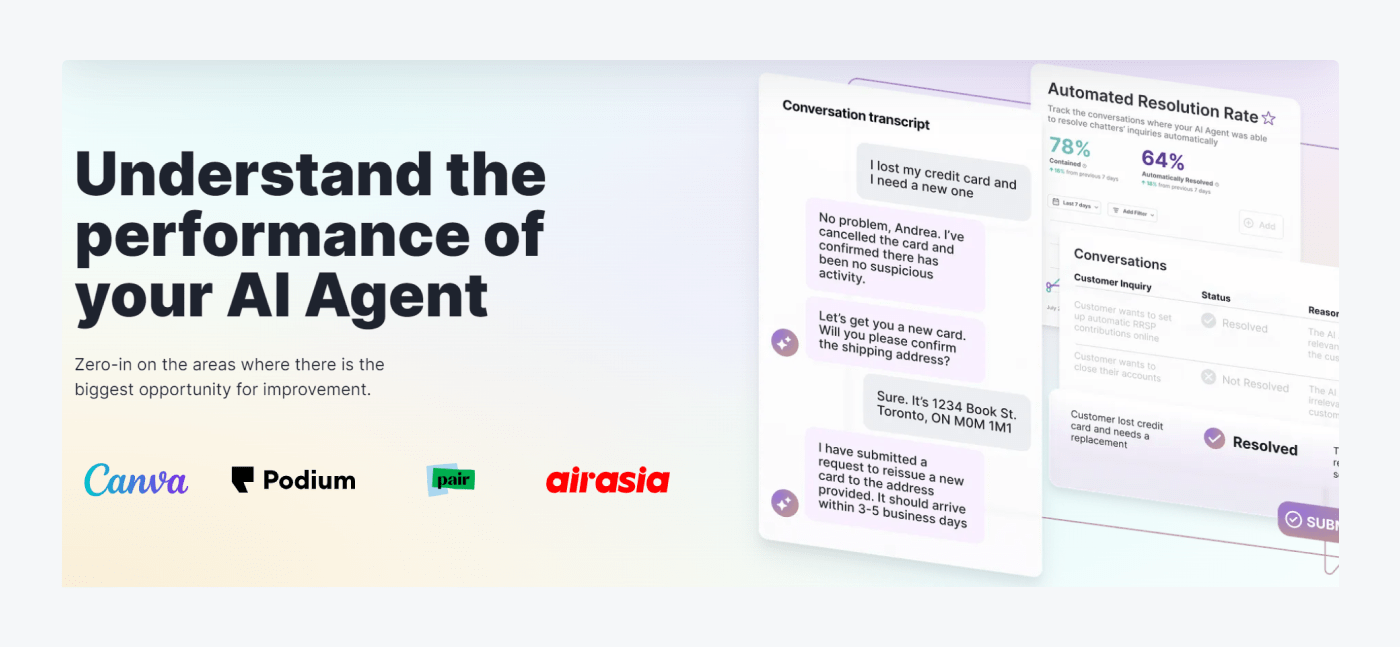
Rating: 4.6/5 ⭐️ (150+ reviews)
Ada is a full-blown AI-powered customer service automation platform that will help transform your client experience. The tool allows you to train your chatbot and guide it towards improvement over time. It also comes with the ability to automate your customer service across multiple platforms and languages. You’ll get to use your chatbots on web, SMS, social media, and phone channels.
Pros:
- Automation across all major messaging channels
- Drag-and-drop chatbot builder
- AI measurement of automated resolutions
- The ability to connect with flexible API integrations
Cons:
- Numbers can be conflicting when gathering data
- Some users experienced bugs when using integrations
- Chatbot → Contact sales
- AI Agent → Contact sales
7. ProProfs Desk
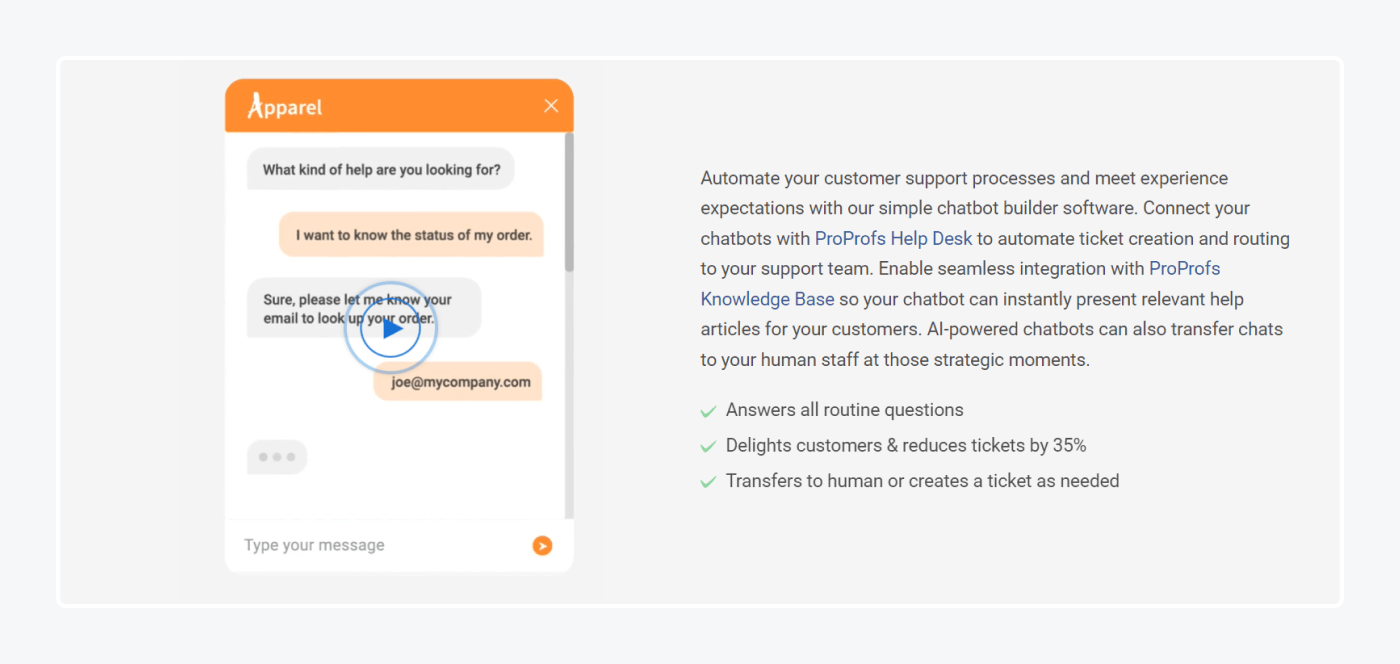
Rating: 4.7/5 ⭐️ (18 reviews)
As a cloud-based support tool, ProProfs Desk can assist businesses in building positive customer relationships. It offers a centralized support management dashboard, allowing agents to resolve tickets faster. Proprofs’ customer support solution offers the ability to create chatbots and respond to clients even when you’re offline.
Pros:
- Shared inbox functionality to manage queries in one place
- Canned responses to use as predefined replies
- Issue tracking system and incident management
- Reporting and analytics available
Cons:
- Integration options can be improved
- Only basic IT ticketing management available
- Free version available for a single user
- Team ($29.99/mo/operator)
- Customer support suite → Contact sales
8. Zoho Desk
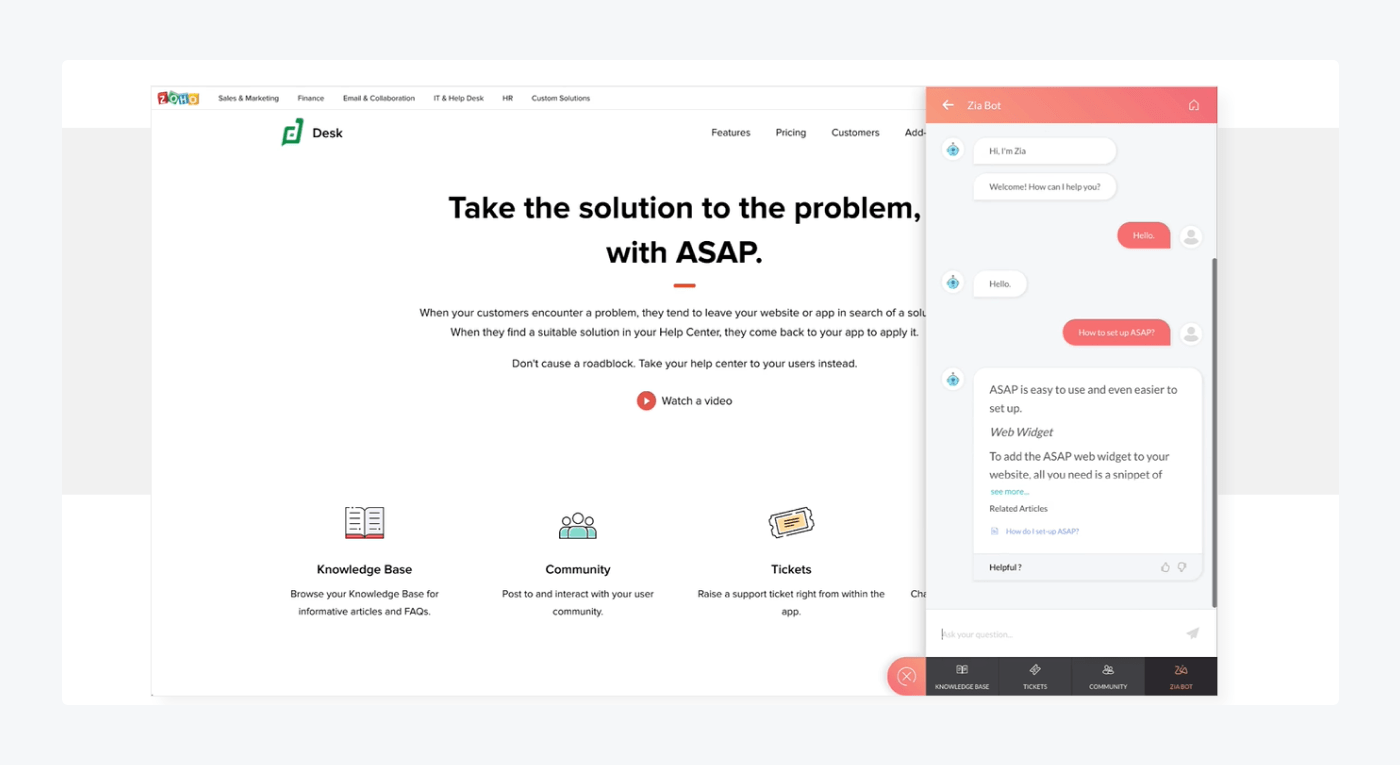
Rating: 4.4/5 ⭐️ (5,390+ reviews)
Zoho Desk is an all-encompassing help desk management tool that allows you full client accessibility and provides customers with quick resolutions. Aside from ticket management, automation, and self-service features, you will also have access to Zia, Zoho’s contextual AI. This tool helps to supercharge your team with reply assistance, the ability to auto-tag tickets, and a knowledge base (KB) bot.
Pros:
- Omnichannel service for web, email, and social media
- Multi-brand help center and lnowledge base
- Generative AI available
- Service level agreements (SLAs)
Cons:
- Needs a longer learning curve to understand all features
- Integrations could be more streamlined and intuitive
- Free trial available
- Express ($9/mo/user)
- Standard ($20/mo/user)
- Professional ($35/mo/user)
- Enterprise ($50/mo/user)
Read more: Check out the top Zoho Desk alternatives you can use for your business.
9. Freshchat
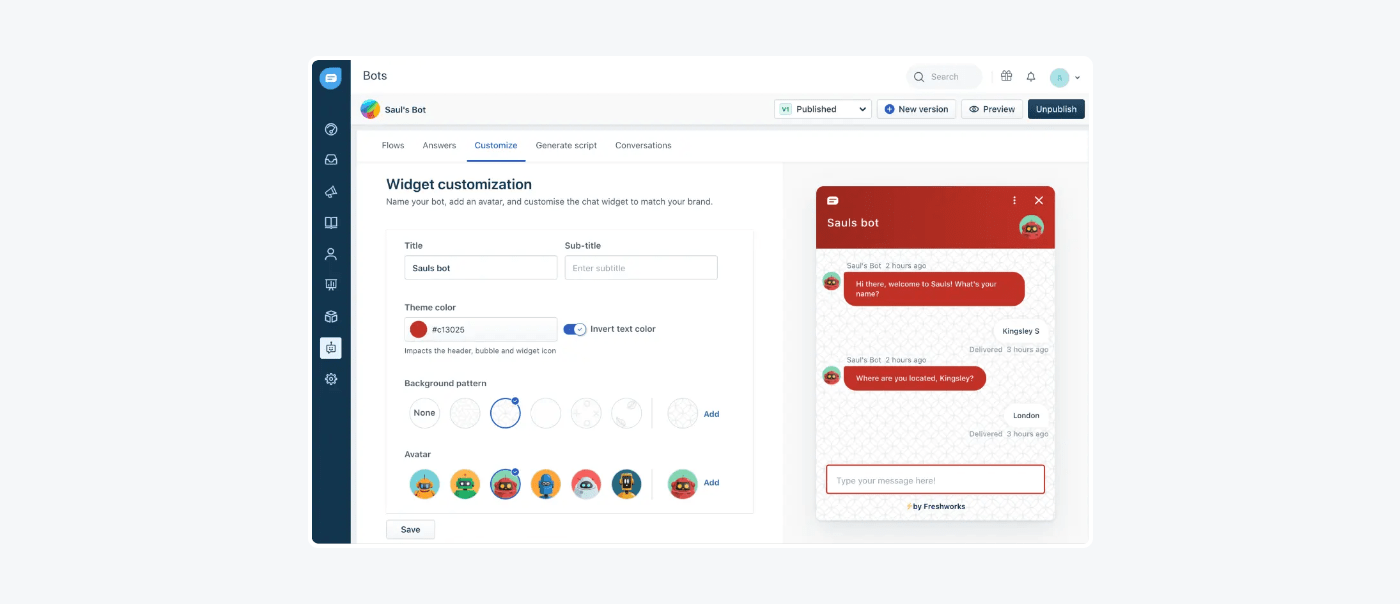
Rating: 4.4/5 ⭐️ (464+ reviews)
Created by Freshworks, Freshchat is a tool that comes with a live chat feature and AI-powered chatbots. It offers everything you may need to engage customers, including the multichannel functionality, web chat widget, canned responses, and FAQ base. You’ll also be able to connect your favorite tools to Freshchat for unified customer support management.
Pros:
- Shared team inbox to access customer intel
- Context-driven bots that provide instant replies
- Messaging channels for mobile, web, WhatsApp, and Facebook
- Multilingual support with 33+ languages
Cons:
- Customer emails may appear as a different person
- Canned responses can appear buggy
- Free version available
- Growth ($23/mo/agent)
- Pro ($59/mo/agent)
- Enterprise ($95/mo/agent)
Read more: Be sure to check out the best Freshdesk alternatives and competitors along with their features and pricing.
10. Drift
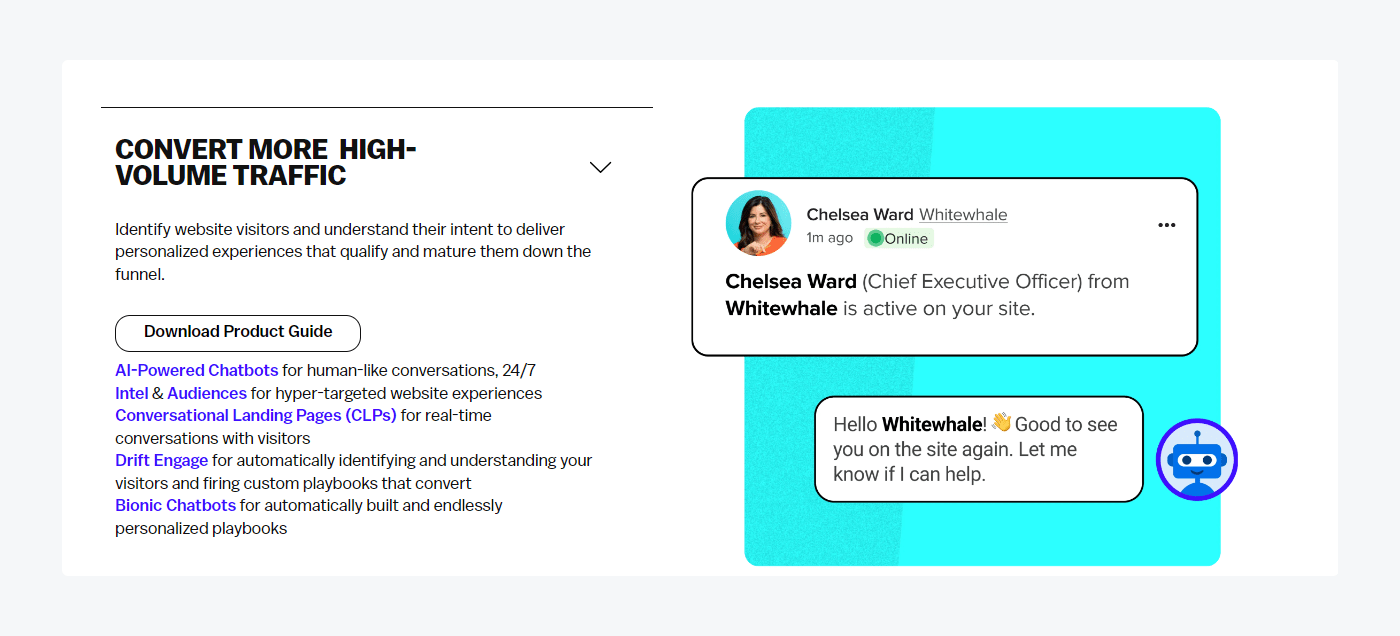
Rating: 4.4/5 ⭐️ (1,145+ reviews)
Drift is an AI-powered platform great for personalizing conversations at every stage of the customer journey. It comes with patented conversational AI and ChatGPT-powered features. You’ll be able to choose from sophisticated AI bots to GPT Suggested Replies to save time when responding to clients.
Pros:
- Live chat, custom bots, and AI chatbots
- Integrations with HubSpot, Drip, Google Analytics, etc.
- Real-time notifications when a user is on a website
- Detailed reporting and analytics dashboards
Cons:
- Occasional live chat glitches
- Appearance of bugs after new feature releases
- Premium (Starting at $2,500/mo)
- Advanced → Contact sales
- Enterprise → Contact sales
Read more: Here are the top Drift alternatives to use for your customer support needs.
You’re now aware of the best customer service chatbot tools for enhancing your support management and helping automate the workload of your reps.
But what are the true benefits they can bring to your business?
Customer service chatbot benefits
A customer service bot is a powerful tool. It can help you improve lead generation, shorten waiting times, increase client satisfaction, alleviate the workload of your agents, and much more.
So, here are the top advantages of using chatbots for customer service:

They are available 24/7
Modern-day customers want to get answers to their questions almost immediately. The good news—bots can send instant replies to user inquiries. Such efficient communication is a great way to convert website visitors into paying customers. In fact, a whopping 64% of consumers think that bots’ 24-hour service is one of their top benefits.
Read more: Check out the Lyro case study to learn how this powerful AI assistant helped Tidio’s support team automate 58% of their conversations.
They save money
Not only does an AI customer service chatbot boost your sales, but it can also save your brand some money. Namely, installing this type of software is much cheaper than employing and training customer service teams. And many chatbot builders and bot templates are even available free of charge.
Moreover, the Business Insider Intelligence report estimates that global retail consumer spending via bots will reach $142 billion this year. Sounds impressive, doesn’t it?
Read more: Check out the best retail chatbot examples, types, and tips.
They provide better customer communication
An AI customer service bot can collect relevant data about clients and use it to improve customer satisfaction. Personalized and targeted support combined with fast response times is a sure way to boost sales and improve the overall user experience. In fact, as many as 40% of people will spend more than planned after a highly personalized experience.
Read more: Learn the most effective customer communication strategies.
They speak multiple languages
According to statistics, over 75% of customers prefer to shop in their own language. And nobody wants to lose potential buyers because of friction in client interactions. The great news for companies is that AI customer service chatbots running on NLP technology are able to easily understand different languages and respond to visitors accordingly.
They come with multiple integrations
It doesn’t matter what platform your website operates on—Shopify, Wix, WordPress, or WooCommerce. There are plenty of solutions available for you to choose from. On top of that, a chatbot doesn’t have to be present only on your website. There are Facebook Messenger, Instagram, and WhatsApp chatbots that can help you stay in touch with your shoppers whenever they need assistance.
They give your brand a unique voice
Well-designed NLP bots make your brand more human and give people a feeling they are engaging with something more than a robot. Plus, adding a bit of personality to a chatbot is sure to attract more visitors. In fact, our chatbot personality study revealed that as many as 53% of consumers build positive associations around brands whose bots use quick-witted comebacks.
It’s now clear what the key benefits of chatbots in customer service are. But what about the main features you should look for?
Customer service chatbot features
When selecting a customer service chatbot for business, it’s important to consider key features that will enhance user experience and improve communication with your audience. Here are the top 5 chatbot features to consider:

Natural Language Understanding
A chatbot with the NLU feature is equipped to understand human language as well as user intent to respond in a conversational manner. This enables the bot to answer queries accurately and engage in meaningful conversations based on individual customer preferences, behavior, and past interactions.
Multichannel functionality
To meet your customers where they are, your chatbot should easily integrate with various digital communication channels—from your website, mobile app, and email, to social media platforms. This crucial feature allows your business to provide consistent support, regardless of the platform your customer prefers to use, enhancing their overall user experience and satisfaction.
Chatbot builder
An ideal chatbot should come with an intuitive builder tool. This feature allows you to easily design, build, and customize your bot without needing extensive coding skills. It should also provide easy-to-use interfaces, drag-and-drop elements, and premade templates to speed up the chatbot creation process.
Routing options
CS chatbots should be able to redirect customers to human agents if they ask for information outside their knowledge scope. To be more precise, when the bot can’t handle complex inquiries or a user is dissatisfied, this feature enables the transfer of the customer to a real person.
Performance analytics
A chatbot should provide valuable data and analytics about its interactions with customers. This helps you to understand visitors’ needs and preferences and make necessary improvements. The chatbot-based analytics should include the total number of conversations, answered and unanswered questions, conversations transferred to an operator, and more.
Okay—
It’s time to check out what these chatbots look like in action.
Customer service chatbot examples
Are there any big companies that are actively using AI customer service bots?
The answer is yes, of course. Numerous companies are leveraging the power of service bots to enhance their interactions with users and streamline operations. These AI-powered tools allow for a 24/7 assistance, quick responses to queries, and efficient problem-solving.
Here are a few notable examples of chatbot use cases for customer service.
1. Endeksa
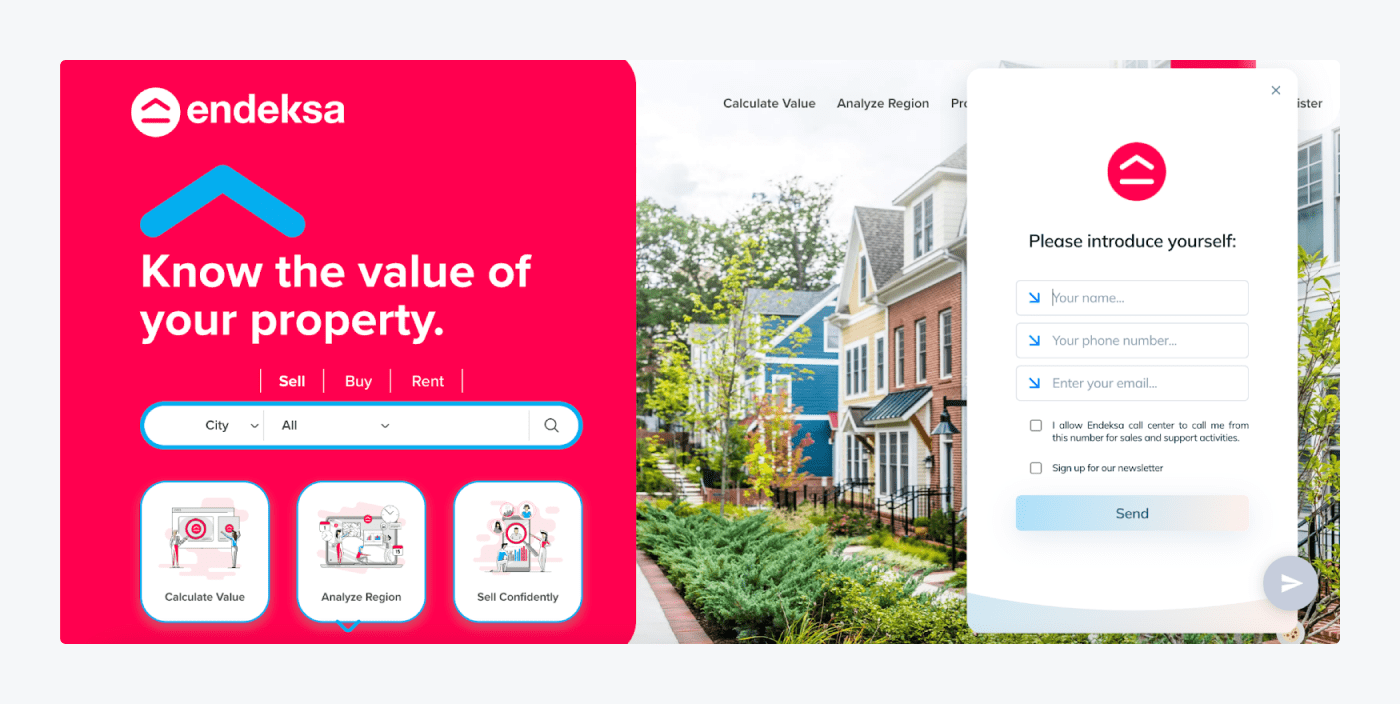
Endeksa, a real estate analytics platform, uses the help of the Tidio support chatbot to transform the customer service experience for their clients. They successfully implemented two different umbrellas for the queries—client support and sales. This customer service chatbot example uses smart pre-chat surveys to collect new leads and a bot that asks for user feedback. This allows the company to learn and improve from clients’ impressions.
Read more: Learn all about how Endeksa achieved a boost in lead generation using Tidio.
2. Domino’s
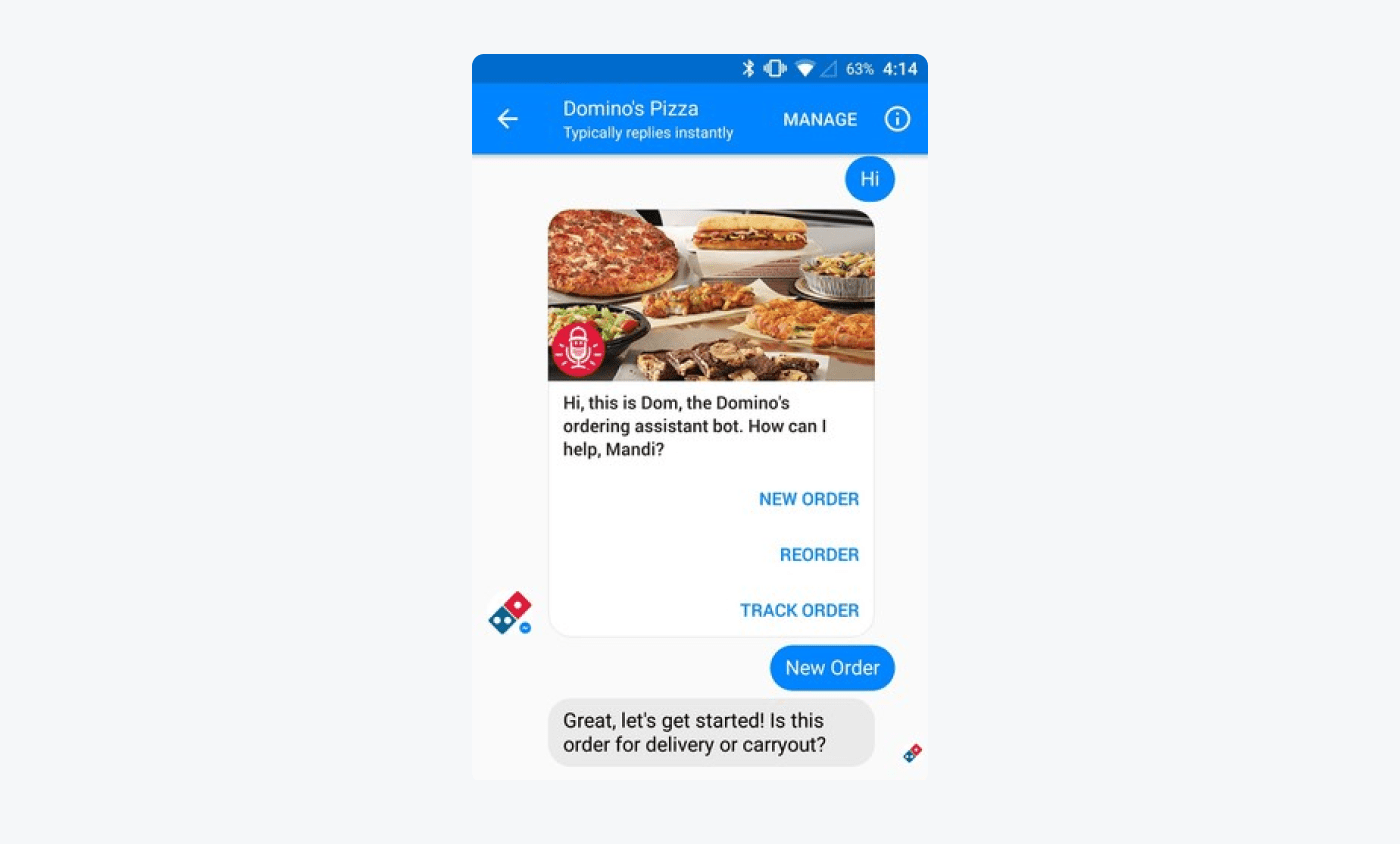
Domino’s Pizza employs a chatbot on its website and app to simplify the process of ordering a meal. Customers can interact with the virtual assistant, provide their preferences, select toppings, and complete their orders seamlessly through natural language conversation. This customer support AI chatbot ensures a smooth and efficient ordering experience without the need to navigate through complex menus.
3. Bank of America

Bank of America’s virtual assistant Erica helps clients with their account inquiries. Customers can ask about their account balance and recent transactions, or even set up alerts for specific activities. The finance bot provides quick and accurate responses, saving customers time and reducing the need to visit a physical branch or wait on hold for assistance.
4. ADT Security Service

Here’s another company that used the help of Tidio bots to enhance clients’ experience. The brand set up rule-based chatbots to provide answers to simple questions. There’s also a discount message that pops up to new visitors and shows special offers, which is an excellent tactic for lead generation.
Read more: Learn all about how this global tech and security company received a boost in customer satisfaction thanks to Tidio.
5. H&M

H&M’s virtual shopping assistant engages with customers seeking fashion advice. Users can describe their preferences and style, and the AI will suggest outfits or clothing items from the store’s collection. This interactive experience can help customers make confident purchasing decisions and offers a personalized shopping assistant.
Read more: Learn how to recreate online in-store experiences and effectively engage clients using chatbots.
6. Sephora

Sephora doesn’t just have a regular customer service bot—it has a virtual beauty guru, offering makeup and skincare advice. Customers can describe their skin type, concerns, and desired looks, and the AI recommends products, application techniques, and even tutorials. This virtual assistant enhances the customer’s shopping journey and provides expertise right at their fingertips.
7. Starbucks
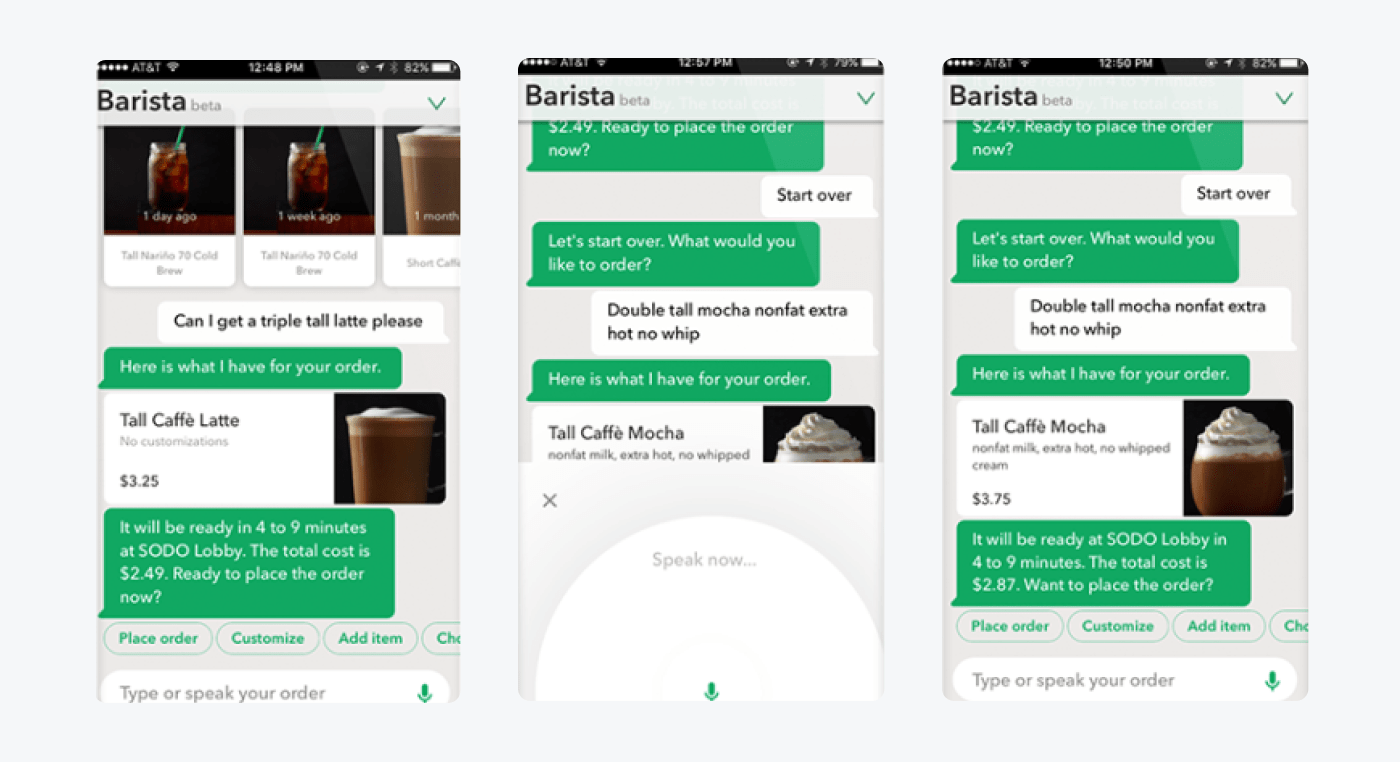
This customer service chatbot example allows users to simplify the process of ordering their drink. How? Starbucks virtual shopping assistant guides the user through the steps of placing an order either via text or voice. It supports natural language processing, completes the payment process with the linked credit card or gift card, and sends a request to a nearby coffee shop to be made. Once the drink is ready for pickup, the bot sends a notification to the client.
8. KLM Royal Dutch Airlines
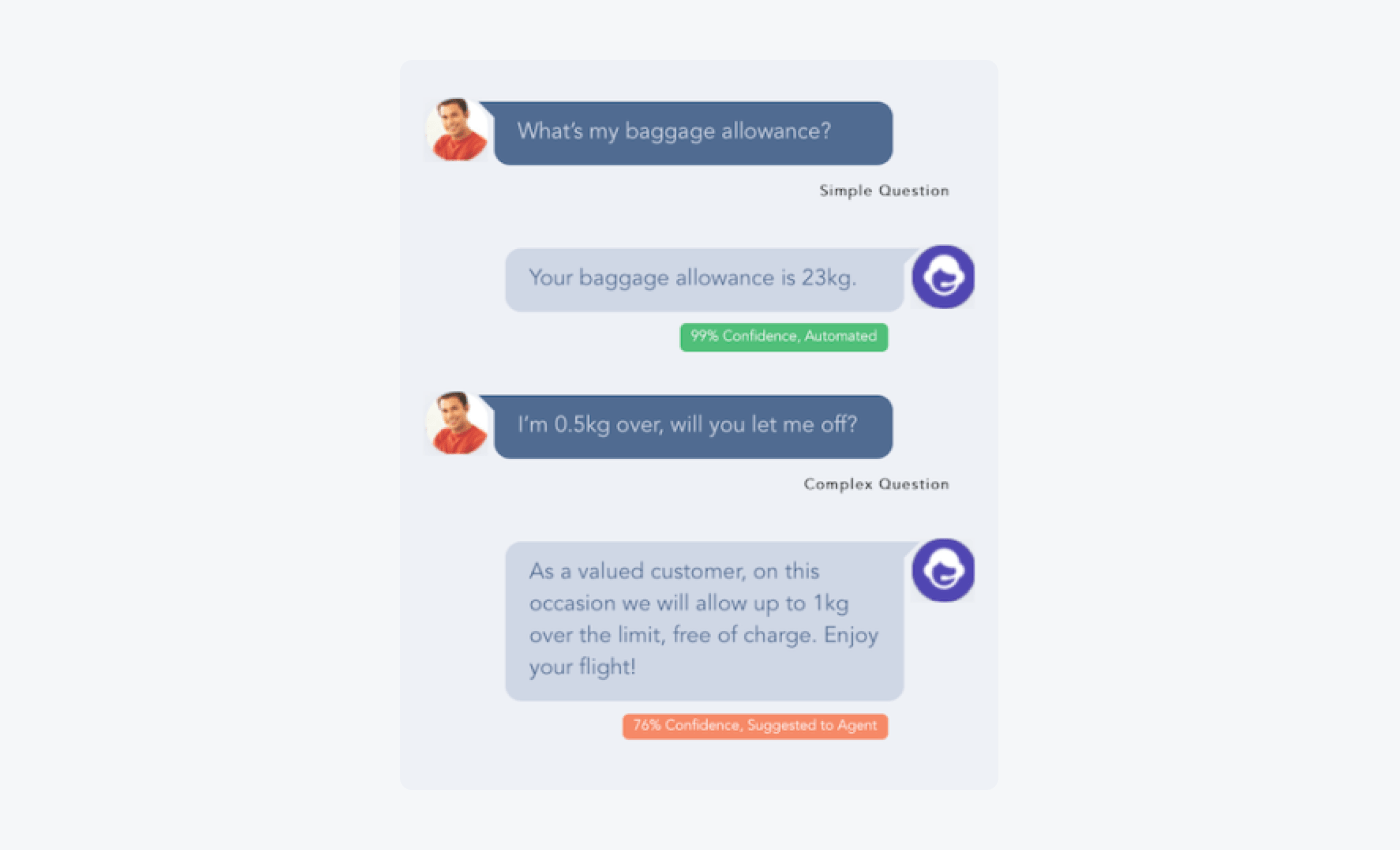
KLM’s virtual assistant keeps travelers informed about their flights. Customers receive real-time updates on flight statuses, gate changes, and baggage information through a messaging app. This customer service AI chatbot helps to ease travel uncertainties and provides convenience by quickly delivering all the crucial information.
9. InboundLabs

InboundLabs uses a bot with a knowledge base, allowing the visitors to receive all relevant information they’re interested in. A user can also select a specific department they need assistance from within the chat dropdown. The LabsBot will then ask for a user’s name and email address, successfully collecting leads in the process.
10. Dollar Shave Club

Dollar Shave Club’s customer support bot provides users with assistance when it comes to the most common issues. All they need to do is select the category relevant to their problem and then keep choosing from the options available in the chat window. For example, if clients need help with their subscriptions, they can ask more about how to change payment info, add or remove products, cancel their subscriptions, etc.
The above-mentioned customer service chatbot use cases all showcase how these bots enhance various aspects of the user experience, from simplifying ordering processes to providing personalized assistance.
With that out of the way, let’s move on to some useful tips you can implement to take your customer service to the next level.
Best practices for using customer service bots
After installing your preferred software, you might be wondering what you can do to make your online customer service chatbot even more efficient.
We got your back—read on for the tips and tricks:

1. Personalize interactions for stellar experiences
One of the chatbot’s superpowers lies in its ability to provide personalized experiences at scale. Our study on chatbot statistics reveals that customers love seeing that a business is client-centric, while companies like these are reported to be 60% more profitable than the rest!
So—
Train your AI bot to respond empathetically and adapt to varying conversational tones, ensuring each interaction feels like a genuine conversation. This includes greeting your visitors by name, adjusting to their tone of voice, and talking on behalf of your company in the unique brand voice.
Read more: Explore the latest AI customer service statistics and trends to learn more about how AI can help your business grow.
2. Embrace and use a multichannel approach
Scaling your business means reaching customers across various platforms. And the solution to this issue is simple: use an omnichannel customer service approach. Implement your bot on multiple channels, like your website, social media, SMS, and messaging apps. But remember to adapt your chatbot’s responses according to different interaction styles while maintaining a unified brand voice. This will help you meet clients wherever they are and ensure consistent support.
3. Build interactive FAQs
It’s a good idea to ensure that your bots are ready to answer any frequently asked questions. This is important as 74% of shoppers prefer chatbots for customer service when asking FAQs and simple queries.
For example, you can use Tidio’s Lyro AI chatbot to automatically pull answers from your existing FAQ base. After enabling Lyro on your site, all you have to do is decide whether you want to add knowledge from your website URL, or if you want to generate it from the existing Q&A.

Read more: Learn all about customer self-service along with its practical examples, key benefits, and useful tips.
4. Use rich text and content
Using different text formatting, like italics, bold text, and underlining is more engaging to read than just plain writing, wouldn’t you agree? And customers love seeing it, too. Rich text adds to how much a company cares about communication and makes the conversation more interactive. This can discourage the visitors from closing the page, so make sure to incorporate it as part of your virtual support strategy.
5. Streamline routine tasks for efficiency
Customer service bots can be your secret weapon to tackle repetitive and time-consuming tasks. By automating routine inquiries, order tracking, and basic troubleshooting, you free up your team to focus on more strategic and complex matters. But ensure you strike a balance between automation and personal touch.
6. Continuously learn and improve
Your bot isn’t a “set it and forget it” tool. So, you should regularly analyze interactions and gather feedback to fine-tune your chatbot’s performance. Chatbots can learn from every conversation, improving their responses and understanding over time. By identifying patterns, refining responses, and adding new capabilities, you ensure your bot evolves as your business scales, offering even better support to an expanding customer base.
All in all, by strategically integrating these virtual assistants into your support routine, you’ll be well on your way to expanding your reach while delivering a top-notch customer service experience.
Finally, let’s see how you can implement a CS bot for your business needs.
How to build a customer service chatbot
The good news is that there are a number of customer service chatbot companies that let you build and install your bots with zero coding skills. Additionally, many of these chatbots can be added to a website in less than 5 minutes.
Sounds too good to be true? Let’s check out the necessary steps you should take to build a customer service bot for your website:

1. Decide the main purpose of your bot
It’s crucial to identify what you want your conversational AI to do and be as specific as possible about it. This could be for the bot to greet new visitors, recover abandoned carts, or answer questions about shipping and returns. It will help you narrow down the features you need, specify the functionality of the bot, and decide how you should customize it.
2. Pick your customer service chatbot provider
Take all of the important factors into account and choose your ideal solution. The good thing is that many services (like Tidio, for example) come with a free plan, so you can try it out before opening up your wallet and find your perfect customer support chatbot service.
3. Design your conversation flow
Log in to the builder of your choice and design the triggers you want the bot to recognize.
If you opt for Tidio, you have the option of using Lyro, Tidio’s conversational AI, and Flows, or rule-based bots that work following the decision tree logic.

To create a chat flow (or rule-based bot) in Tidio and activate it on a specific landing page, start with a Visitor opens a specific page command. Write the message you want your flow to send and then activate it with a simple click of a button.
To create an AI-powered bot using Tidio, just head to the Lyro tab and hit the button Start using Lyro. You can choose to import an FAQ from your website’s URL or add one from an external page. Lyro will automatically get the question-answer pairs from the URL and generate bots for you.

4. Test your bot
It’s crucial to double-check if everything is running as smoothly as possible.
To test Tidio’s chat flow, you can click the Test it out button and see a live preview of your flow as customers see it. Check the conversation flow and correct it if necessary.

To test out Lyro conversational AI, head to the Lyro tab and click on Test Lyro. From then on, you can double-check Lyro’s knowledge by typing a question to see how it responds.

It’s also important to ask a variety of questions to your bot directly on your website and see how it responds.
5. Monitor bot analytics and collect user feedback
In order to consistently provide an excellent support experience with your customer service chatbots, it’s vital to always measure how your tool is performing so ensure you can easily view your metrics on the bot platform. Moreover, you should be ready to implement necessary changes based on feedback and analytics.
Here’s how to easily analyze the most important KPIs using Tidio:

Read more: Discover how to create a bot from scratch in 8 easy-to-follow steps.
Customer service chatbots: key takeaway
And that’s it—we’ve reached the end of our guide. Let’s do a quick recap of what we learned:
- An online customer service chatbot is an AI-powered computer program that helps businesses provide stellar customer support
- These bots offer better communication, are available 24/7, save money, and give a brand its unique voice
- When choosing the best chatbot for customer service, consider your business size and your purposes first
- A well-trained chatbot in customer service is becoming a must—many big brands like Starbucks, Sephora, and Domino’s use them
- Integrating such a bot can be done in a couple of easy steps without any coding skills
It seems like customer service chatbots are here to stay. Moreover, they are becoming a golden standard for businesses. So, this is exactly the time to go ahead and install one for your needs.
Frequently Asked Questions (FAQs)
A customer service bot is a type of artificial intelligence tool programmed to interact with customers in a natural, human-like manner. These bots can conduct real-time conversations, process requests, respond to queries, and offer 24/7 assistance on different platforms. They can either operate based on a set of pre-determined instructions or utilize more advanced machine-learning algorithms for more complex interactions.
A customer service chatbot works by simulating conversations with customers through programmed responses or by learning from previous interactions. They operate with either a predefined set of rules or more advanced machine learning and natural language processing (NLP) algorithms. Rule-based bots answer queries according to specific command inputs whereas AI chatbots leverage artificial intelligence to learn from each customer interaction and adapt.
Bots can greatly improve customer service by providing instant responses and round-the-clock support. Furthermore, chatbots can handle regular queries and issues efficiently, allowing human support agents to manage more complex customer requests. They also handle transactions and provide personalized recommendations, enhancing customer experience.
No, they will never completely replace human representatives. Chatbots are ideal for handling routine and repetitive tasks, while support reps can focus on complex issues and provide a more human touch.
Security is a top priority in the development of customer service chatbots. Personal customer data and payment information are typically encrypted and follow rigorous data protection regulations. Also, reputable customer support chatbot providers maintain high-security measures to avoid data breaches. However, like any other digital platform, absolute safety can’t be guaranteed, so ongoing efforts are necessary to maintain and enhance security.
The level of maintenance required for a bot can vary depending on the complexity of the bot. Simple, rule-based chatbots may require very little maintenance. On the other hand, more complex, AI-driven chatbots may need regular updates and supervision to ensure that they continue to learn from client interactions.
Tidio’s Lyro is a notable example among the leading AI chatbots for customer service. It’s capable of pulling answers from the existing FAQ base or a company’s website. On top of that, it can successfully provide info to all commonly asked questions in a human-like language, alleviating your customer support and boosting the number of solved queries.


